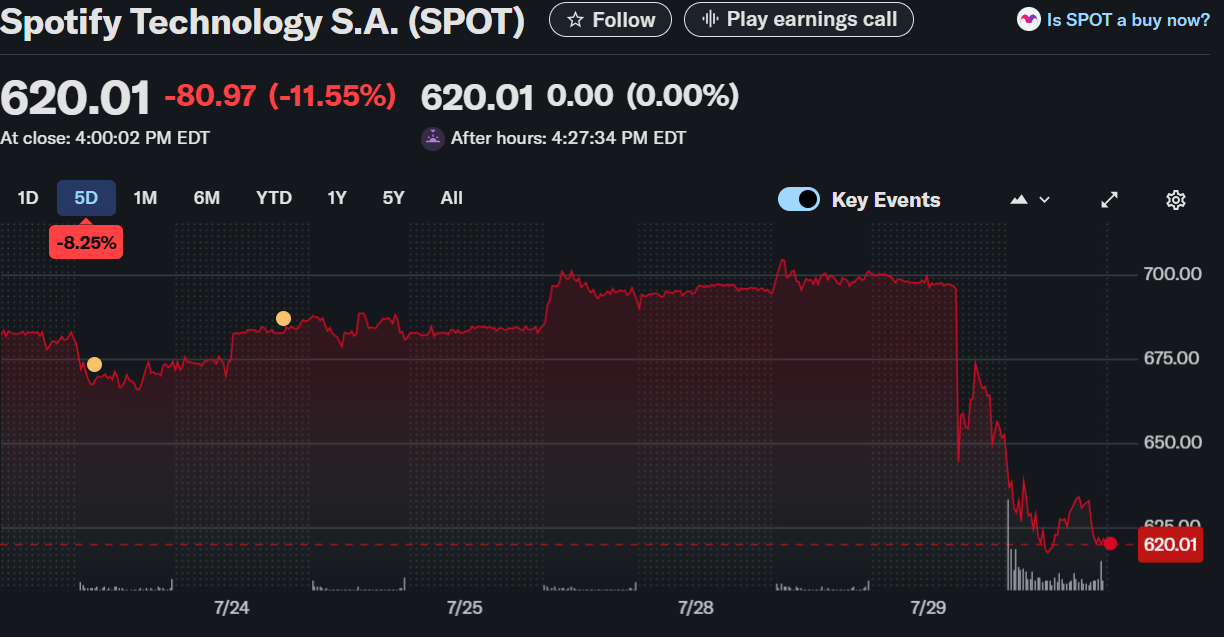Spotify ($SPOT) Q2 Shock: Subscribers Up, Profits Down – What’s Going Wrong?
Spotify’s Q2 earnings drop a sour note despite user growth hitting the right chords. Wall Street expected a profit encore—but got a revenue flatline instead.
The subscriber surge that wasn’t enough
Another quarter, another million-plus users flooding Spotify’s platform. Too bad ‘free cash flow’ wasn’t on the setlist.
Ad-supported blues
Premium tier growth? Solid. Ad revenue? Still playing catch-up to the giants. Another reminder that eyeballs don’t always equal earnings.
The analyst chorus chimes in
‘Show us the money!’ screams the Street, as yet another tech darling proves that growth doesn’t guarantee profits. Cue the ‘when will they monetize properly?’ refrain.
Spotify’s dancing to its own beat—but investors are getting tired of waiting for the profitability hook to drop. Maybe next quarter they’ll finally turn the volume up on earnings. Or maybe they’ll just roll out another podcast no one asked for.
TLDR
- Spotify stock dropped 9.83% to $632.08 following Q2 results
- Paid subscribers rose 12% to 276 million, beating expectations
- Monthly active users climbed 11% to 696 million
- Q2 operating profit rose 52.6% to €406M but missed €539M forecast
- AI content and video strategy remain focus areas despite cost headwinds
Spotify Technology S.A. (NYSE: SPOT) traded at $632.08 at the time of reporting, down 9.83%, after releasing mixed Q2 2025 results.

Spotify Technology S.A. (SPOT)
While the Swedish streaming giant posted strong user growth, its profits fell short of estimates due to increased operating costs. Earnings swung to a loss of €0.42 per share, sharply missing analysts’ projection of €1.97 in profit.
User Growth Exceeds Expectations
Spotify reported 276 million premium subscribers, marking a 12% increase from the previous year. The number surpassed the 273.2 million expected by analysts. Monthly active users jumped 11% year-over-year to 696 million, also exceeding projections of 689.2 million. CEO Daniel Ek highlighted user loyalty and Spotify’s platform evolution, stating that “People come to Spotify and they stay on Spotify.”
Spotify, $SPOT, Q2-25 Results:
📊 EPS: ≈−$0.46 (−€0.42)
💰 Revenue: ≈$4.57B (€4.19B)
📈 Net Loss: ≈$94M (€86M)
🔎 MAUs and Premium Subscribers beat guidance; Free Cash FLOW hit a record €700M despite operating income missing forecast due to higher Social Charges pic.twitter.com/65ZUwXjYBW
— EarningsTime (@Earnings_Time) July 29, 2025
Profit Miss Driven by Social Charges and Revenue Mix
Despite strong user growth, Spotify’s operating profit of €406 million, up 52.6% from last year, fell short of its €539 million forecast. The miss was largely attributed to €98 million in unexpected “social charges,” or payroll taxes, resulting from share price gains during the quarter. The company also pointed to a shift in its revenue mix and higher salary expenses as reasons for the profit shortfall.
AI and Video Content Take Center Stage
Spotify is investing heavily in AI-powered features and video content to differentiate itself from rivals. Its recent advertising push includes AI-generated voiceovers to help brands cut costs on audio campaigns. The company is also expanding into video content, including music videos, concerts, and podcasts, to compete with platforms like YouTube.
Q3 Forecasts and Analyst Disappointment
Looking ahead, Spotify expects Q3 revenue to rise to €4.2 billion, though that’s below Wall Street’s forecast of €4.48 billion. Operating income is projected at €485 million, well under the expected €569.5 million. Spotify forecasts premium subscribers will hit 281 million and monthly active users will reach 710 million in the next quarter. A weaker dollar is expected to weigh on revenue.
Performance Overview: SPOT vs. S&P 500
Trailing total returns as of July 29, 2025, show Spotify far outpacing the broader market. Its YTD return stands at 41.31%, while the S&P 500 has gained 8.43%. Over the past year, SPOT surged 95.27% compared to the index’s 16.72%. The three-year return is an impressive 459.35% against the S&P’s 54.40%, and the five-year return is 141.10% versus the index’s 95.71%.

